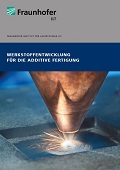Eutectic cast alloys are characterized by a combination of a solid-solution crystal phase and a, secondary hard phase. As the two phases solidify simultaneously, a characteristic, often lamellar, solidification morphology is produced. In additive manufacturing, the lamellar spacing can be precisely adjusted since the microstructure can be refined by several orders of magnitude, up to nanoscale dimensions, which cannot be achieved by conventional casting. Due to the layered construction, the grain size of the structure is largely independent of component geometry. Since the microstructure is refined, the material’s strength increases and the ductility decreases only moderately. With nanoscale solidification both strength and ductility can be increased.
Today, the eutectics systems Fe-C and Al-Si are used almost exclusively for technical purposes. However, there are many more eutectics that have not yet been used due to casting difficulties. These include special Al- and Ti-based eutectics that are of interest as lightweight materials.

 Fraunhofer Institute for Laser Technology ILT
Fraunhofer Institute for Laser Technology ILT